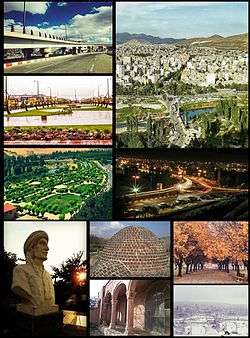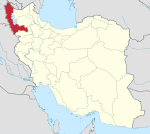Bukan
| Bukan بوکان | |
|---|---|
| City | |
 Bukan | |
 Bukan | |
| Coordinates: 36°31′16″N 46°12′32″E / 36.52111°N 46.20889°ECoordinates: 36°31′16″N 46°12′32″E / 36.52111°N 46.20889°E | |
| Country |
|
| Province | West Azerbaijan |
| County | Bukan |
| Bakhsh | Central |
| Government | |
| • Parliament | Mohammad Qasem Osmani |
| Elevation | 1,365 m (4,478 ft) |
| Population (2016 Census) | |
| • Estimate (2017) | 194,846 |
| • Urban | 193,501 [1] |
| Time zone | UTC+3:30 (IRST) |
| • Summer (DST) | UTC+4:30 (IRDT) |
| Area code(s) | (+98) 44-462 |
| Website | www.bukan.ir |
Bukan (Persian: بوکان; also Romanized as Bukān, (Kurdish: Bokan)[2] is the capital of Bukan County, West Azerbaijan Province, Iran, one of 14 cities and towns in the province. As of 2017, its population was estimated to be near 194,846 in 57,000 families,[3] making it the third most populous city of the province. Its distance from the province′s capital is 184 kilometres. Seventy-five percent of the population is settled in the urban area, while 25% live in the rural area (Iran 2012 Census). This population is almost a homogeneous Kurdish-speaking. community.[4]
Etymology
History
Pre–Islamic era
There have been several artefacts discovered in Bukan dating back to between 4100 BC and 4400 BC. These artefacts confirm that Bukan was home to one of the first human settlements on the Iranian Plateau.[6] Bukan was also at the centre of the Mannaean civilization.[7]
In Pre–Islamic times Bukan was a garrison for both the Parthian Empire and the Sassanian Empire There are several ancient sites from this time period in Bukan today.[8] Bukan was also under the control of different empires such as the Middle Assyrian Empire, the Medes, and the Urartu. Environmentally and climatically, Bukan is a highland with snow-capped mountains which looks like as beauty queen of Kurdistan. As regard to the history of the area, according to the archaeological findings, it should be said that from the earliest time the district of Bukan had been populated by ancient tribes, who were inhabited in the foothills of Zagros mountain chain. Archaeologically, the oldest remains that has been recovered here come from Gharagouz (4800-4100 Dalma), Nachit and Gharakend mounds (Bronze Age) The cultural sequence of Bukan, however, has been continued up to Qajar dynasty. There have been recovered more than 150 sites in Bukan.[9]
Islamic era
Bukan fell into the hands of the Muslims some time around 643.[10] In the 15th century, a local by the name of Amirseifolldin Makari brought the area under his control. Shah Ismail I of the Safavid Dynasty tried several times unsuccessfully to try to bring the area back under his control.[11]
Modern era
In the year 1853, under the rule of Naser al-Din Shah Qajar, Bukan was no more than a small village.[12]
After the 1979 Iranian Revolution Bukan was faced with turmoil, and fell under the control of Kurdish opposition groups. Bukan was liberated by the Iranian Armed Forces on 1 January 1984. According to the IRGC, Bukan was the last Kurdish city in Iran to be freed.[13] On 15 April 1988, Bukan was bombarded by the Iraqi Air Force, in which 19 people died and 160 were wounded.[14]
Geographic location
Bukan is located south of Lake Urmia about 1,300 to 1,370 metres above sea level. It lies in the West Azarbaijan Province of Iran. The town is situated on the eastern bank of the Simineh River (Turkic: Tatahūčāy), known locally as Čōmī Bukan, on the road between Saqqez and Miandoab.[15]
Demographics
The residents of Bukan speak the Sorani dialect of Kurdish and are predominantly adherents of the Sunni Islam religion.[16] In 2012, 93% of the city's population was Muslim.[17] There is a visible minority of Shia Muslims in Bukan, and in the past there was a number of Jewish families living in the city.
Historical sites
Sardar Castle
In 1247 Persian Date, Sardar Aziz Khan Mukri from Sardasht region built a castle near the great reservoir of bukan that presently named after its founder as Sardaar Aziz khaan Castle. The Castle has been built on top of a hill 50 by 60 in diameter and 13 meters hegit and its main building materials is bricks of 20 by 20 cm with gley mrtar and timbers. The Castle measures 25 by 30 meters and has 6 daises which rest upon 9store colmns 2meters hegiht and 1 meter diameter .
During 1325-1351 (A.H) the castle turns into police headquarters, post office, and as school respectively and finally was destroyed completely in 1361 A.H and replaced by a newly built structure that used as Basidj (Mobilization) Station.
| Wikimedia Commons has media related to Bukan. |
Sports
Football is the most popular sport in the city. Bukan is host to professional club Sardar Bukan who play in the Iranian League 2 (third tier). In 2017, Sardar Bukan gained a nationwide reputation for its support from the people of Bukan.
Notable people
Friendship cities
References
- ↑ https://www.amar.org.ir/english
- ↑ Bukan can be found at GEOnet Names Server, at this link, by opening the Advanced Search box, entering "-3057083" in the "Unique Feature Id" form, and clicking on "Search Database".
- ↑ "Amar Iran population in 2017".
- ↑ Rahim Farrokhnia (Iranian Kurds: A Case Study of Bukan) 2006-2012,University Hamadan, Iran
- ↑ https://web.archive.org/web/20150915193950/http://www.noorlib.ir/View/fa/Book/BookView/Image/19856/1/194?SearchText
- ↑ https://web.archive.org/web/20150916061058/http://www.irancities.ir/showcity.aspx?code=65&code2=11
- ↑ محمودپدرام، ۳۰–۳۵
- ↑ نینا ویکتورینا پیگولوسکایا، شهرهای ایران در روزگار پارتیان و ساسانیان، ۳۳.
- ↑ hassanzade,Yuosef,izertu historical Monuments (Bukan) 2007, ISBN 9789640401408
- ↑ https://web.archive.org/web/20150915193950/http://www.noorlib.ir/View/fa/Book/BookView/Image/19856/1/194?SearchText
- ↑ مردوخ، تاریخ مشاهیرکُرد جلد دوم، ٣٧١-٣٧٢.
- ↑ http://rojhalat.de/laperekan/nuseran/Kak%20Anwer/bokan/bokan.pdf
- ↑ https://web.archive.org/web/20150916062004/http://www.farsnews.com/printable.php?nn=13910701001266
- ↑ https://web.archive.org/web/20160410021425/http://ziryan.ir/NewsDetail.aspx?itemid=13653
- ↑ "بررسی اهمیت و نقش رودخانه های سیمینه رود و زرینه رود در توسعه بخش کشاورزی آذربایجان غربی" [The Rivers Zarrineh and Simineh, their importance and role in the development of the agricultural sector in Western Azerbaijan] (in Persian). Agriculture Organization of West Azerbaijan. 20 April 2012. Archived from the original on 22 February 2014.
- ↑ https://www.ethnologue.com/language/ckb
- ↑ http://poldasht.ostan-ag.gov.ir/Login?returnurl=%2fAdmin%2fDevice-Preview-Management%2fPageContentID%2f87
External links
- Bukan entry in the Encyclopædia Iranica
- Mannaean glazed bricks from Bukan
